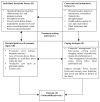Rethinking the economic costs of malaria at the household level: evidence from applying a new analytical framework in rural Kenya
- PMID: 16939658
- PMCID: PMC1570360
- DOI: 10.1186/1475-2875-5-76
Rethinking the economic costs of malaria at the household level: evidence from applying a new analytical framework in rural Kenya
Abstract
Background: Malaria imposes significant costs on households and the poor are disproportionately affected. However, cost data are often from quantitative surveys with a fixed recall period. They do not capture costs that unfold slowly over time, or seasonal variations. Few studies investigate the different pathways through which malaria contributes towards poverty. In this paper, a framework indicating the complex links between malaria, poverty and vulnerability at the household level is developed and applied using data from rural Kenya.
Methods: Cross-sectional surveys in a wet and dry season provide data on treatment-seeking, cost-burdens and coping strategies (n = 294 and n = 285 households respectively). 15 case study households purposively selected from the survey and followed for one year provide in-depth qualitative information on the links between malaria, vulnerability and poverty.
Results: Mean direct cost burdens were 7.1% and 5.9% of total household expenditure in the wet and dry seasons respectively. Case study data revealed no clear relationship between cost burdens and vulnerability status at the end of the year. Most important was household vulnerability status at the outset. Households reporting major malaria episodes and other shocks prior to the study descended further into poverty over the year. Wealthier households were better able to cope.
Conclusion: The impacts of malaria on household economic status unfold slowly over time. Coping strategies adopted can have negative implications, influencing household ability to withstand malaria and other contingencies in future. To protect the poor and vulnerable, malaria control policies need to be integrated into development and poverty reduction programmes.
Figures





References
-
- Gallup J, Sachs J. The economic burden of malaria. Am J Trop Med Hyg. 2001;64:85–96. - PubMed
-
- McCarthy D, Wolf H, Wu Y. Malaria and Growth. Policy Research Working Paper. World Bank, Washington, DC; 1999.
-
- World Bank Economics of malaria: Summary of facts and figures. Press release. 1999.
-
- World Bank . Poverty reduction and the health sector. World Bank's poverty reduction strategy source book. World Bank, Washington DC; 2001.
Publication types
MeSH terms
Grants and funding
LinkOut - more resources
Full Text Sources
Medical

